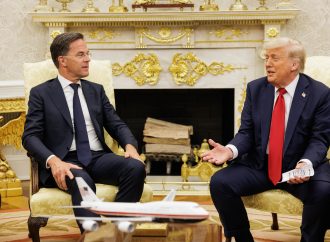NATO commits partners to act in case of an attack of against any single partner. Each alliance partner will take the actions it deems necessary to assist the Ally attacked. Reality is more nuanced than politicians, pundits, and critics admit. That notwithstanding, the alliance’s Eastern Flank includes heterogeneous partners with differing threats and priorities concerning how NATO should defend the area. The Eastern Flank includes the Baltic trio, Bulgaria, Czechia, Hungary, Poland, Romania, Slovakia, along with Greece & Turkey. Eleven states together contributing 12.8607% of 2024 NATO cost-shares (relative to US-German matching shares, 15.8813% each).
This contribution explores the disconnect between discussions fueled by NATO’s addiction to the 2% military spending target and Central & Eastern European (henceforth, CEE) partner pragmatic ‘operating realities’. Such forces generate ‘performative honesty’ where partners ‘meet’ common targets, but analysis reveals underperformance. Though ‘shadows of the future’ (i.e., personnel, training and equipment demands) offer collaborative opportunities, focus remains on how performative (dis)honesty (using Czech data) affects operational realities (from 20 years of Baltic Air Policing data) leading to several recommendations.
1. Considering selected activities on NATO’s Eastern Flank
Canada’s leadership of the Latvian brigade as part of NATO’s Enhanced Forward Presence in four (enlarged to eight) Eastern partners remains important. The Latvians will lobby the commitment, since 2016, to extend beyond 2026. Canada leads with the most partners of any group and includes alliance partners with the smallest economies/militaries (e.g., Latvia, along with Albania, Czechia, Denmark, Iceland, Italy, Montenegro, North Macedonia, Poland, Slovakia, Slovenia, Spain, Sweden, and the US).
The brigade includes historically close neighbours in a rare ‘estrangement’ (the Czechs and Slovaks). Slovak elections in the fall of 2023 yielded a government uncomfortably distant from the NATO-favoring status quo and subsequently in March 2024 a rupture occurred with its closest partner leading to the suspension of intergovernmental consultations at top-levels. Despite an assassination attempt on the newly elected Slovak leader, bickering over ‘restarting’ relations continues. A (symbolic) presidential visit at the end of June did occur even though unsuspending intergovernmental consultations remained off the agenda. Strained bilateral relations are a potential weakness affecting group unity.
2. Implications for NATO
NATO identity (i.e. ‘We are NATO’), is built through socialisation, practices, shared intersubjective understandings in international (institutional) environments along with communicated expectations through shared language and strategic culture(s). Though credibility is endogenous to the design of cooperation international (defence) commitments, trust is temporally revealed through practice behaviors, adhering to standards, meeting expectations, participating in exercises, etc. The aggregation of those activities conveys deterrence credibility through signaling the quality of club capabilities, its willingness to defend members, and capacity to effectively interoperate. NATO relies on the aggregation of contributions facing interoperability & readiness realities (language challenges, joint doctrine implementation). CEE partners varied concerning the speed at which they shed communist military organisational structures, defence planning models, and leadership practices which shapes readiness, notwithstanding problems replacing Soviet equipment and differences in respective defence industrial bases.
3. Challenges to future club cooperation
‘Shadows of the future’ include club concerns with implications for shared behavior/unity. For example, (dis)honesty in reporting is a recurrent NATO problem affecting club outputs. Czech defence personnel attainment of NATO (English) language standards, per NATO STANAG 6001, reveal a consistent inability to meet targets (attaining under 60% regularly). The observed to planned ratio of military personnel meeting NATO’s Standardised Language Profiles (SLP) English levels rose from 33% to 58% but under austerity in 2015 it fell to 27% for those attaining ‘professional’ levels relative to what was planned. And no Czech military personnel attained top-level SLP (ranging from 1-4 indicating survival, functional, professional, expert) despite a targeted number of 131 persons from 2004-2020. Figure 1 indicates how obtention of professional-level English was a barrier to participation in IMET activities for Czech military personnel from 2005-2017. The club’s operational language, as a shared language, coordinates and facilitates communication.
The blue line. which indicates Czech defence personnel reaching ‘functional-level’, constrains the following year’s participation in International Military Education and Training, i.e., the orange line. Performative honesty is meeting under 60% of expected targets, and (dis)honesty may be failing to produce any SLP military personnel at expert-levels English a quarter decade after accession. Recalling English is the language of NATO’s PME institutions, Centres of Excellence, the club’s operational effectiveness relies upon effectively combining military capacities to undertake club-mandated missions communicated through (expert-level) English.
Baltic Air Policing for the past two decades has permitted recently admitted partners a (mostly) non-conflict(ual) club operation. Poland, Romania, Czechia, and Hungary are Eastern flank contributors with Turkey (see appendix table 2). Together since 2006 the air forces of those five Eastern Flank partners aggregated for 2,272 days (18% of the total flight-operation-days) with Poland contributing over 50% among the group averaging over 100 days throughout 12 years while the Romanians, Czechs, and Hungarians contributed each to three different years. Seventeen states combined in groups of 3 to 10 annually over the two decade-long mission. Though importantly because their respective air forces were much smaller, their risk loss ratios were much larger in the mission when contributing; the ‘realities’ of their respective air forces.
4. Recommendations
NATO’s Eastern Flank partners, facing territorial threat, contribute to club collective deterrence activities. That notwithstanding the variation across Eastern Flank partners reveals the heterogeneities of each’s respective capacities. Turkey strongly contributes to Eastern Flank activities alongside an increasingly powerful Poland with Hungarian, Czech, and Romanian support. The rest of the Flank contributes when possible. Those partners also contribute, more than would be expected based on military spending, to the club through hosting and participating in NATO Centres of Excellence which shape defence force and club transformation using various identified mechanisms ranging from binding (protocol, doctrine work) to practice activities (exercises, training).
Club weaknesses may arise along fracture lines – material loss exposure risks and underperformance (unpreparedness) challenging interoperability during a potential crisis due to cultural/organizational misunderstandings, political confusions over response command & control, and communication difficulties related to CEE defences forces not producing a threshold number of personnel professionally functional in English.
This blog is part of the ‘NATO’s Eastern Flank’ series. Find all of the blogs here.
Learn more about the related conference NATO’s Eastern Flank: Challenges and Implications in the Context of the Ukraine War.
Appendix:












